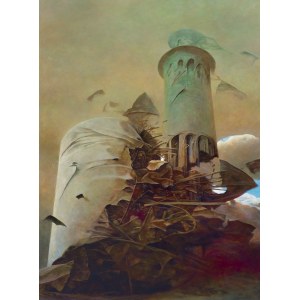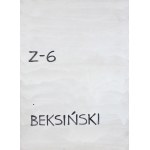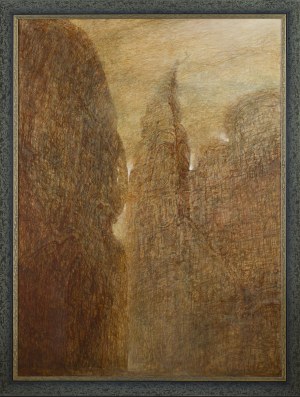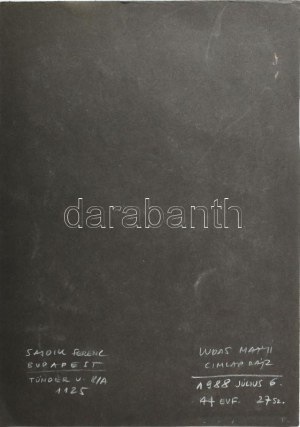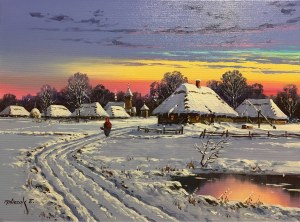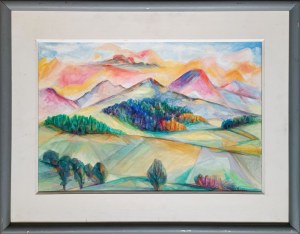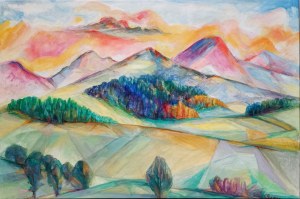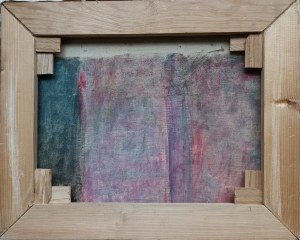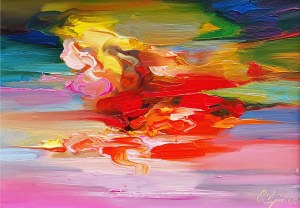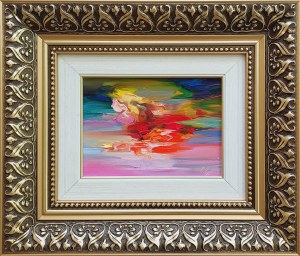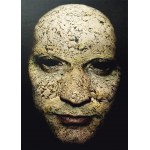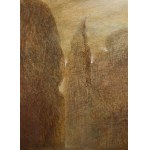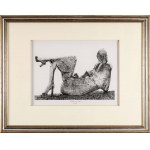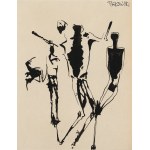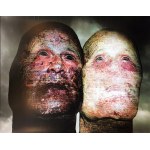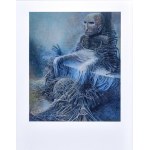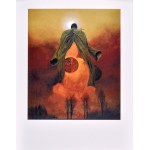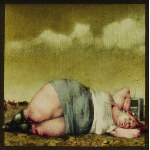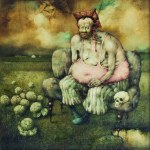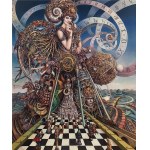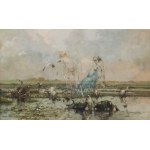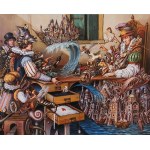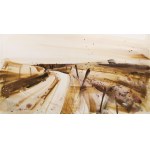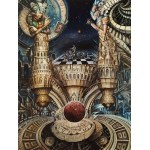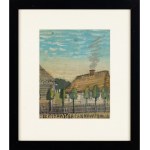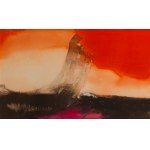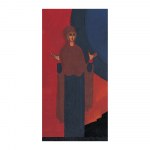signed on the reverse: Z-6 | BEKSIŃSKI
p.g. export stamp with signature
Provenance:
- The painting was purchased in 1990 in Paris for the Museum of European Art in Osaka, Japan.
- After the museum closed, a private collection in Asia.
Painting exhibited, reproduced and described:
- Beksinski. Paris-Osaka-Warsaw, Agra-Art Gallery, Warsaw 1 July - 4 September 2021, cat. no. 25, pp. nlb. color ill;
- Japanese Collection. Beksinski et al, Agra-Art, Warsaw 2021, p. 78, color ill;
- Dmochowski Gallery NET (Virtual Museum) website.
* A border VAT of 8% will be added to the auctioned price in addition to other costs (in accordance with §12 item 2 of the Rules).
♣ to the price auctioned, in addition to other costs, a fee will be added, resulting from the right of the creator and his heirs to receive remuneration in accordance with the Act of February 4, 1994 - on Copyright and Related Rights (droit de suite).
Z-6 - which is one of many variations on the theme of architecture in the painter's art - was created as a result of a commission agreement concluded with art dealer Piotr Dmochowski in late December 1987. Under it, the artist undertook to produce sixteen works stylistically similar to the group of metaphysical landscapes of the second half of the 1970s, which were devoid of any clear "death designators." Dominant among them - shrouded in an aura of magic and mystery - were melancholic views of boundless seas, romantic ruins and deserted ghost towns. The architectural motifs appearing there were far from realism and, as the painter emphasized, had nothing to do with his training as an architectural engineer. They were "photographed visions" close to the poetics of dreams, which were supposed to be pretty not in what they express, but in the position of paint, in the juxtaposition of colors, in the shaping of form(Nic innego nie potrafię [in:] E. Dzikowska, Polscy artyści w sztuce świata, Warsaw 2005, p. 18).
The representation of illusory buildings lifted by a violent gust of wind offered in this catalog is undoubtedly one of the best realizations of this idea. Resembling a lighthouse, the arcaded tower and the cylindrical structure next to it - caught in the destructive vortex of air - are slowly being destroyed. Despite the perfectly smooth - as the artist called it - "licked" - surface of the painting, the composition is extremely expressive. Achieving such an effect was quite a challenge for the painter: My problem is that I would like to be both expressive and solidly finished in my work. It's Scylla and Charybdis, because in the popular perception expression is associated with gesture and shouting. The greater the expression, the more "splashy" the image or formally simplified the photomontage. The more attention to the illusion of space, attention to detail and solidity of execution, the less expression. So my personal way of intensifying expression in works that are solidly finished and perhaps even overly elegantly executed is deformation, because I have an unexplained - even to myself - need to be expressive, but at the same time well-painted(Paćkam, paćkam, aż się obraz namaluje, interviewed by E. Likowska, "Przegląd", no. 28-134, 2002). It was in the tendency to constantly transform and "improve" the plastic material that lay the phenomenon of the art of "Beks" - a perfectionist, who transformed an inherently static motif, which would seem to be architecture, into a dynamic, impressive painting.
(Sanok 24 II 1929 - Warsaw 21 II 2005) studied from 1947 to 1952 at the Faculty of Architecture of the Cracow University of Technology.
He was a self-taught artist who achieved an unquestioned position in Polish contemporary art, confirmed by the presence of his works in prestigious exhibitions and museum collections. He was initially involved in photography, which he had been interested in since his student years, after 1956 gaining recognition as a creator of photograms with an aesthetic based on textural effects. In 1958-1962, he created abstract paintings-reliefs of rich texture, mainly metal, which are a variation of matter painting. Toward the end of this period, he created openwork forms with figure shapes and full-bodied sculptures in metal. The next stage of his work was 1962-1974, when he devoted himself mainly to drawing. In the 1960s he drew with pen and ink figural compositions characterized by caricatured deformation of figures. From the late 1960s, he created charcoal and crayon drawings, a monochromatic variant of his parallel painting work. Since 1974, he has dealt almost indivisibly with painting. His distinctive style was based on technical perfection, accompanied by an extraordinary vision. He painted a post-disaster world, marked by the stigma of death and decay. His paintings are populated by figures and creatures with admittedly human or animal shapes, but with the characteristics of phantoms, automatons or decaying corpses. The artist did not give his paintings and drawings titles (except for ordering symbols), thus emphasizing his lack of interest in the literary side of the depictions. He himself said that when painting he completely surrenders to the vision, "photographing" it. In recent years, he has incorporated electronic image generation techniques into his artistic technique, which he used to create computer photomontages. Beksinski's art, which has been exhibited and discussed many times, arouses extreme emotions among experts and the public.
The largest, systematically replenished collection of his works in the country is in the Historical Museum in Sanok, abroad - in Paris, in the possession of Piotr Dmochowski, who has been collecting works and promoting the artist's work since 1983. He organized individual exhibitions of Beksinski's works at, among others, Galerie Valmay in Paris in 1985, 1986 and 1988, as well as a permanent exhibition at Dmochowski's own Galerie - Musée-galerie de Beksinski, which existed from 1989 to 1996. He also published monumental albums of the artist in 1988 and 1991.
In Poland, Beksinski's monograph by Tadeusz Nyczek was published by Arkady in 1989 (second edition in 1992). In the spring of 2005, a major exhibition of Beksinski's paintings took place at the Abbotsford Palace in Gdansk Oliva, and the director of the Sanok Museum Wieslaw Banach published a comprehensive monograph on the artist.
Since October 2016, an exhibition of 250 works (paintings, drawings, photographs) by Zdzislaw Beksinski from the private collection of Anna and Piotr Dmochowski has been permanently installed at the Nowa Huta Cultural Center. Meanwhile, a permanent exhibition of 30 Beksinski paintings from the Dmochowskis' collection has also been on display at the Archdiocese Museum in Warsaw since June 2021.
(Photo: Piotr Dmochowski, CC BY-SA 3.0, https://commons.wikimedia.org/w/index.php?curid=8960820 )



